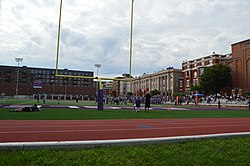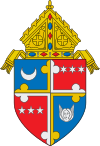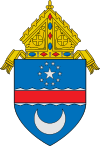St. John's College High School is a Catholic high school in Washington, D.C. Established in 1851, is the third oldest Christian Brothers school in the United States, and was one of the oldest Army JROTC schools until the program was abolished in 2019 in pursuit of a private “leadership academy” program with no relationship to the United States Armed Forces.

Anthony Kohlmann was an Alsatian Catholic priest, missionary, theologian, and Jesuit educator. He played a decisive role in the early formation of the Archdiocese of New York, where he was the subject of a lawsuit that for the first time recognized the confessional privilege in the United States, and served as the president of Georgetown College from 1817 to 1820.

Joseph Burchard Villiger was appointed Santa Clara University's fourth president in 1861 after the presidency of Felix Cicaterri. Burchard Villiger had served as the president of two Jesuit Colleges in the east. During his presidency at Santa Clara University in California United States he had built the Science Building, a Jesuit Residence, and the Facade of the Old Mission Church. He served as president till 1865 which coincided with the Civil War. Later Villiger was rector of the College of the Sacred Heart in Woodstock, Maryland.

William Matthews, occasionally spelled Mathews, was an American who became the fifth Roman Catholic priest ordained in the United States and the first such person born in British America. Born in the colonial Province of Maryland, he was briefly a novice in the Society of Jesus. After being ordained, he became influential in establishing Catholic parochial and educational institutions in Washington, D.C. He was the second pastor of St. Patrick's Church, serving for most of his life. He served as the sixth president of Georgetown College, later known as Georgetown University. Matthews acted as president of the Washington Catholic Seminary, which became Gonzaga College High School, and oversaw the continuity of the school during suppression by the church and financial insecurity.
Adam Marshall was an American Catholic priest and Jesuit. He briefly served as president of Washington Seminary, and later became the first Catholic chaplain in the United States Navy, albeit unofficially.

Charles William Lyons was an American Catholic priest who became the only Jesuit and likely the only educator in the United States to have served as the president of four colleges. Born in Boston, Massachusetts, he attended the local public schools before entering the wool industry. He abandoned his career in industry to enter the Society of Jesus. While a novice in Maryland, he suffered a nervous breakdown and was sent to Georgetown University as prefect. He then resumed his studies at Woodstock College, teaching intermittently at Gonzaga College in Washington, D.C. and Loyola College in Baltimore. After his ordination, he became a professor at St. Francis Xavier College in New York City and at Boston College.
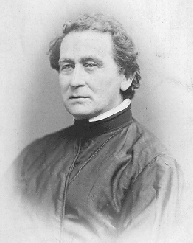
Anthony Francis Ciampi was an Italian priest of the Catholic Church and member of the Society of Jesus.
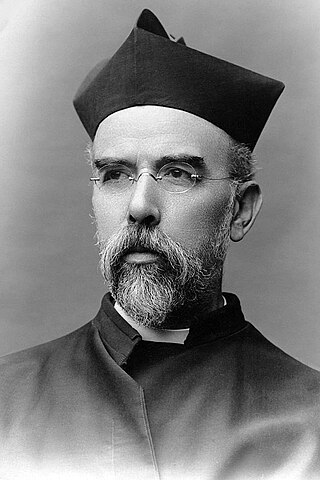
Joseph J. Himmel was an American Catholic priest and Jesuit. For much of his early life, he was a missionary throughout the northeast United States and retreat master. Later in life, he was president of Gonzaga College and Georgetown University in Washington, D.C.
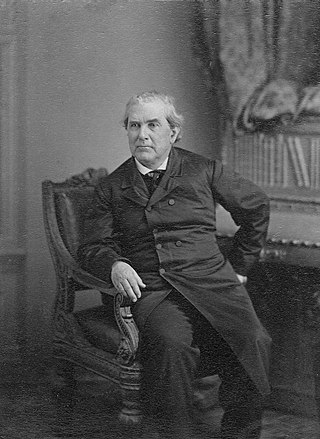
Charles Henry Stonestreet was an American Catholic priest and Jesuit who served in prominent religious and academic positions, including as provincial superior of the Jesuit Maryland Province and president of Georgetown University. He was born in Maryland and attended Georgetown University, where he co-founded the Philodemic Society. After entering the Society of Jesus and becoming a professor at Georgetown, he led St. John's Literary Institution and St. John the Evangelist Church in Frederick, Maryland. He was appointed president of Georgetown University in 1851, holding the office for two years, during which time he oversaw expansion of the university's library. The First Plenary Council of Baltimore was held at Georgetown during his tenure.

David Hillhouse Buel Jr. was an American priest who served as the president of Georgetown University. A Catholic priest and Jesuit for much of his life, he later left the Jesuit order to marry, and subsequently left the Catholic Church to become an Episcopal priest. Born at Watervliet, New York, he was the son of David Hillhouse Buel, a distinguished Union Army officer, and descended from numerous prominent New England families. While studying at Yale University, he formed an acquaintance with priest Michael J. McGivney, resulting in his conversion to Catholicism and joining the Society of Jesus after graduation.

Jerome Daugherty was an American Catholic priest and Jesuit who served in many different capacities at Jesuit institutions throughout the northeast United States, eventually becoming president of Georgetown University in 1901. Born in Baltimore, he was educated at Loyola College in Maryland, before entering the Society of Jesus and becoming a member of the first class at Woodstock College. He then taught various subjects, including mathematics, Latin, Ancient Greek, rhetoric, and the humanities in Massachusetts, New York City, and Washington, D.C., and served as minister at many of the institutions there.

Arthur Aloysius O'Leary was an American Catholic priest and Jesuit, who served as president of Georgetown University in from 1935 to 1942. Born in Washington, D.C., he studied at Gonzaga College before entering the Society of Jesus and continuing his education at St. Andrew-on-Hudson and Woodstock College. He then taught at St. Andrew-on-Hudson and Georgetown University, where he eventually became the university's librarian, and undertook a major improvement of the Georgetown University Library. O'Leary then assumed the presidency of the university in the midst of the Great Depression and, later, World War II.
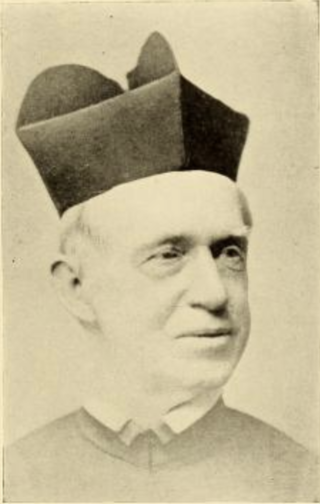
William Francis Clarke was an American Catholic priest and Jesuit who held several senior positions at Jesuit institutions in Maryland and Washington, D.C. Born in Washington, he descended from several early colonial families of Maryland. He was educated at Gonzaga College and its successor institutions during the suppression of the Society of Jesus, followed by Georgetown College. After his entrance into the Jesuit order, he taught for several years at Georgetown, and became the pastor of St. Joseph's Church in Baltimore, where he took uncommon measures to integrate black Catholics and Italian immigrants into parish life.

Cornelius Gillespie was an American Catholic priest and Jesuit who served as the president of Gonzaga College in Washington, D.C., and twice as president of Saint Joseph's College in Philadelphia. He was the first head of Saint Joseph's College to have been an alumnus of the school.
Joseph Eugene Gallery was an American Catholic priest and Jesuit. He studied sociology at Georgetown University, before serving in the U.S. Army during World War I. Upon his return, he graduated, and entered business in Washington, D.C. He then entered the Society of Jesus in 1931, and was later ordained a priest. He became a professor of sociology at the University of Scranton, and also worked in child welfare and in arbitrating industrial disputes. In 1947, Gallery became the president of the University of Scranton. During his presidency, the university's graduate school was established. His term came to and end in 1953, and he continued to teach sociology at Saint Joseph's College in Philadelphia.
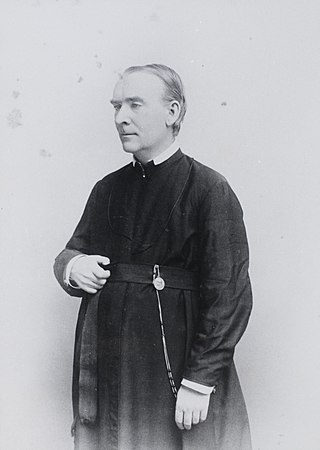
Edward Ignatius Devitt was a Canadian American priest, Jesuit, and historian of the American Catholic Church. Born in Saint John, New Brunswick, he moved with his family to Boston, Massachusetts, at a young age. He studied in public schools in the city before enrolling at the College of the Holy Cross. Devitt spent two years there, and then entered the Society of Jesus in 1859. He studied at the novitiate in Frederick, Maryland, and at the newly opened Woodstock College. He briefly taught at the Washington Seminary during his studies, and after graduating, was a professor for the next thirty years at Holy Cross, Woodstock, and Georgetown University.

Robert James Fulton was an American Catholic priest and Jesuit who twice served as the president of Boston College, from 1870 to 1880 and 1888 to 1891. He was influential in the early years of Boston College, as he was in charge of all the school's academic affairs.
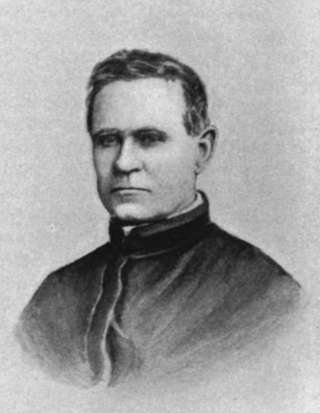
James Clark was an American Catholic priest and Jesuit who led the College of the Holy Cross during the American Civil War as president from 1861 to 1867. Born in Pennsylvania, he was educated at the United States Military Academy and served as an officer in the U.S. Army for one year, before converting to Catholicism and later entering the Society of Jesus.
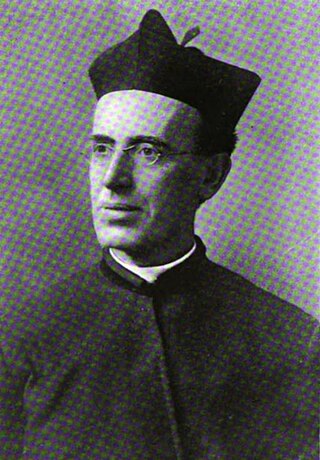
Edward A. McGurk was an American Catholic priest and Jesuit who was the president of Loyola College in Maryland from 1877 to 1885 and the president of the College of the Holy Cross from 1893 to 1895. Born in Philadelphia, he entered the Society of Jesus in 1857. He taught at Holy Cross before becoming the president of Loyola College, where he liquidated some of the school's debt, which had accrued during the Civil War. In 1885, McGurk became the president of Gonzaga College in Washington, D.C. During his tenure, he constructed a new residence for the Jesuits and scholastics.



